NELLCOR NPB-40 User Manual

OPERATOR’S MANUAL
NPB-40
Handheld Pulse Oximeter
Caution: Federal law (U.S.) restricts this device to sale by or on the order of a physician.
To contact Mallinckrodt’s representative: In the United States, call 1-800- 635.5267; outside of the United States, call your local Mallinckrodt representative.
© 2001 Mallinckrodt Inc. All rights reserved. 060328B-0601
0123

Nellcor Puritan Bennett Inc. 4280 Hacienda Drive Pleasanton, CA 94588 USA
Telephone Toll Free 1.800.NELLCOR
Tyco Healthcare UK LTD
Fareham Road
Gosport
PO13 0AS
U.K.
Tel: 44.1329.224000
Nellcor Puritan Bennett Inc. is a wholly-owned subsidiary of Mallinckrodt Inc. Nellcor and Nellcor Puritan Bennett are trademarks of Mallinckrodt Inc.
To obtain information about a warranty, if any, for this product, contact Mallinckrodt Technical Services Department, or your local Mallinckrodt representative.
The following are trademarks of Mallinckrodt Inc.: Durasensor, Oxiband, Oxisensor, Oxisensor II, OxiCliq, and Dura-Y.
Covered by one or more of the following U.S. Patents and foreign equivalents: 4,621,643; 4,685,464; 4,700,708; and 4,770,179.

CONTENTS |
|
Figures |
|
Tables |
|
Figures ............................................................................... |
iii |
Tables ................................................................................ |
iii |
SAFETY INFORMATION ......................................................... |
1 |
General Safety Information ................................................ |
1 |
INTRODUCTION ...................................................................... |
3 |
Intended use ...................................................................... |
3 |
General Operating Principles and Conditions ................... |
3 |
CONTROLS, INDICATORS, AND SYMBOLS ......................... |
5 |
Displays, Controls, Indicators, and Connectors ................ |
5 |
Other NPB-40 Symbols ...................................................... |
7 |
Description of Controls ...................................................... |
8 |
Function Keys .............................................................. |
8 |
Status Icons ................................................................. |
8 |
Description of Visual Indicators and Displays .................... |
9 |
Description of Audible Indicators ....................................... |
10 |
SETUP ...................................................................................... |
11 |
Unpacking and Inspection.................................................. |
11 |
Testing ............................................................................... |
11 |
List of Components ............................................................ |
11 |
Optional Accessories ................................................... |
11 |
Monitor Setup ..................................................................... |
12 |
Installing the Batteries.................................................. |
12 |
General ........................................................................ |
13 |
NELLCOR SENSORS .............................................................. |
15 |
Selecting a Sensor ............................................................. |
15 |
Biocompatibility Testing ............................................... |
16 |
Performance Considerations ............................................. |
16 |
START-UP AND USE............................................................... |
19 |
Basic Operation ................................................................. |
19 |
Power-On Self-Test (POST) ........................................ |
20 |
Monitoring Mode .......................................................... |
21 |
Pulse Search Mode ..................................................... |
22 |
Determining Software Version ........................................... |
23 |
Silencing or Adjusting Pulse Beep Volume ....................... |
23 |
Turning Display Light (Backlight) On or Off ....................... |
23 |
Storing Event Data ............................................................. |
23 |
Printing Event Data ............................................................ |
24 |
iii

Contents
Preparing the NPB-40 for Printing ............................... |
24 |
Single Event Report ..................................................... |
26 |
Multiple Event Report .................................................. |
27 |
Printer and Printer Accessories ................................... |
28 |
Sensor Disconnect Indicator .............................................. |
28 |
Battery Operation............................................................... |
28 |
Disposal of Device Components ....................................... |
29 |
Performance Considerations.............................................. |
30 |
Impact of Patient Conditions on Monitor Readings...... |
30 |
TROUBLESHOOTING AND MAINTENANCE ......................... |
31 |
Troubleshooting ................................................................. |
31 |
EMI Interference ................................................................ |
33 |
Obtaining Technical Assistance ......................................... |
34 |
Returning the NPB-40 ....................................................... |
34 |
Maintenance ...................................................................... |
35 |
Service ......................................................................... |
35 |
Cleaning....................................................................... |
35 |
Periodic Safety Checks ...................................................... |
35 |
SPECIFICATIONS ................................................................... |
37 |
Performance ...................................................................... |
37 |
Electrical ............................................................................ |
38 |
Environmental .................................................................... |
38 |
Physical.............................................................................. |
39 |
APPENDIX: PRINCIPLES OF OPERATION ............................ |
41 |
Oximetry Overview............................................................. |
41 |
Automatic Calibration................................................... |
42 |
Functional Versus Fractional Saturation...................... |
42 |
Measured Versus Calculated Saturation..................... |
43 |
FIGURES |
|
Figure 1: NPB-40 Front/Side View ........................................... |
5 |
Figure 2: NPB-40 Front Panel Display...................................... |
6 |
Figure 3: NPB-40 Rear View .................................................... |
6 |
Figure 4: NPB-40 Top View ...................................................... |
7 |
Figure 5: Installing Batteries ..................................................... |
12 |
Figure 6: Aligning the NPB-40 and Printer ................................ |
25 |
Figure 7: Single Event Report................................................... |
26 |
Figure 8: Multiple Event Report ................................................ |
27 |
Figure 9: Oxyhemoglobin Dissociation Curve........................... |
43 |
TABLES |
|
Table 1: Nellcor Sensors........................................................... |
15 |
iv
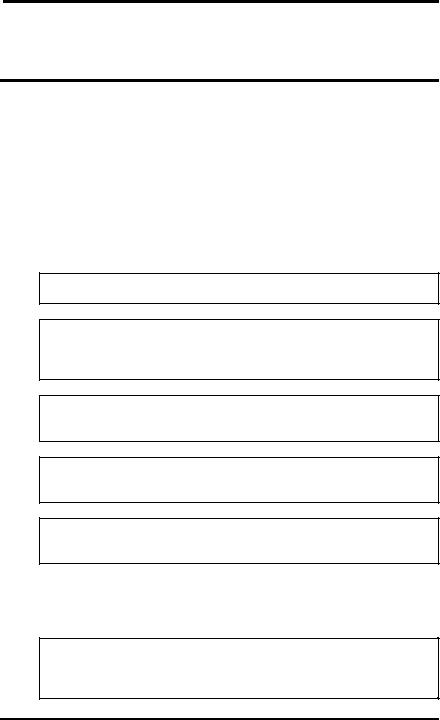
SAFETY INFORMATION
General Safety Information
GENERAL SAFETY INFORMATION
This section contains important safety information related to general use of the NPB-40 monitor. Other important safety information appears throughout the manual in sections that relate specifically to the precautionary information. Be sure to read all text surrounding all precautionary information.
Important! Before use, carefully read this manual, accessory directions for use, all precautionary information in boldface type, and specifications.
WARNING: The NPB-40 is a prescription device and is to be operated by qualified personnel only.
WARNING: The NPB-40 is not equipped with alarms. The monitor is for attended monitoring only, and must be used under the direct supervision of a qualified health care provider.
WARNING: Explosion hazard. Do not use the NPB-40 pulse oximeter in the presence of flammable anesthetics.
WARNING: The cover should be removed only by qualified service personnel. There are no userserviceable parts inside.
WARNING: To ensure accurate performance and prevent device failure, do not expose the NPB-40 to extreme moisture, such as rain.
Caution: The NPB-40 is intended only as an adjunct in patient assessment. It must be used in conjunction with clinical signs and symptoms.
WARNING: Pulse oximetry readings and pulse signal can be affected by certain ambient environmental conditions, sensor application errors, and certain patient conditions.
1

Safety Information
To ensure accurate readings, consider the environmental conditions that are present and the condition of the patient. See the appropriate sections of the manual for specific safety information related to these conditions.
WARNING: If you are uncertain about the accuracy of any measurement, check the patient’s vital signs by alternate means, then make sure the monitor is functioning correctly.
2
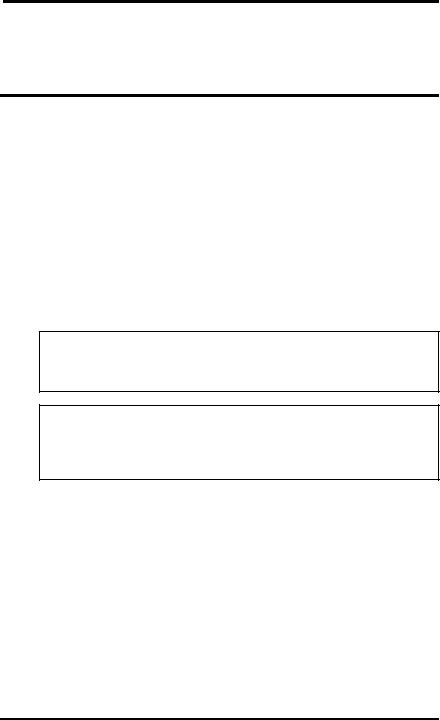
INTRODUCTION
Intended Use
General Operating Principles and Conditions
INTENDED USE
The Nellcor NPB-40 handheld pulse oximeter is intended for noninvasive spot-check measurement of functional oxygen saturation of arterial hemoglobin (SpO2 ), and pulse rate (measured by SpO2 sensor).
The monitor is intended for use on adult, pediatric, and neonatal patients. It can be used in mobile environments when protected from excessive moisture such as direct rainfall.
Caution: The NPB-40 is intended only as an adjunct in patient assessment. It must be used in conjunction with clinical signs and symptoms.
WARNING: The NPB-40 is not equipped with alarms. The monitor is for attended monitoring only, and must be used under the direct supervision of a qualified health care provider.
WARNING: Do not use the NPB-40 or Nellcor sensors during magnetic resonance imaging (MRI) scanning. Induced current could potentially cause burns. The NPB-40 may affect the MRI image; the MRI unit may affect the accuracy of oximetry measurements.
Caution: The NPB-40 may be used during defibrillation, but the readings may be inaccurate for a short time.
The battery-operated NPB-40 is designed to send previously stored patient data to an external Hewlett-Packard HP82240B printer, available from Mallinckrodt.
GENERAL OPERATING PRINCIPLES AND CONDITIONS
The NPB-40 uses pulse oximetry to measure oxygen saturation in the blood. Pulse oximetry works by applying a sensor to pulsating arteriolar vascular bed, such as a finger or toe. The sensor contains a dual light source and a photodetector.
3

Introduction
Bone, tissue, pigmentation, and venous vessels normally absorb a constant amount of light over time. The arteriolar bed normally pulsates and absorbs variable amounts of light during the pulsations. The ratio of light absorbed is translated in an oxygen saturation measurement (SpO2).
Because a measurement of SpO2 is dependent on light from the sensor, excessive ambient light can interfere with this measurement.
WARNING: Pulse oximetry readings and pulse signal can be affected by certain ambient environmental conditions, sensor application errors, and certain patient conditions.
Specific information about ambient environmental conditions, sensor application, and patient conditions, is contained throughout this manual.
4
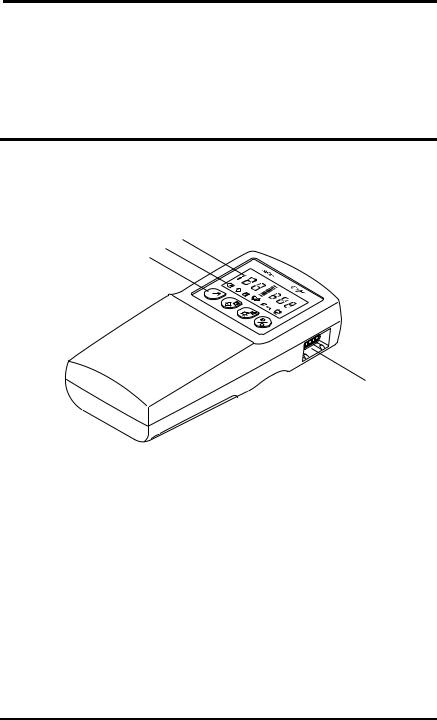
CONTROLS, INDICATORS, AND SYMBOLS
Displays, Controls, Indicators, and Connectors
Other NPB-40 Symbols
Description of Controls
Description of Visible Indicators and Displays
Description of Audible Indicators
DISPLAYS, CONTROLS, INDICATORS, AND CONNECTORS
Figures 1 through 4 show the front, side, rear, and top views of the NPB-40 and identify displays, controls, and connectors.
3
2
1
4
1. Function keys
2. Status icons
3. Digital display
4. Sensor port
Figure 1: NPB-40 Front/Side View
5
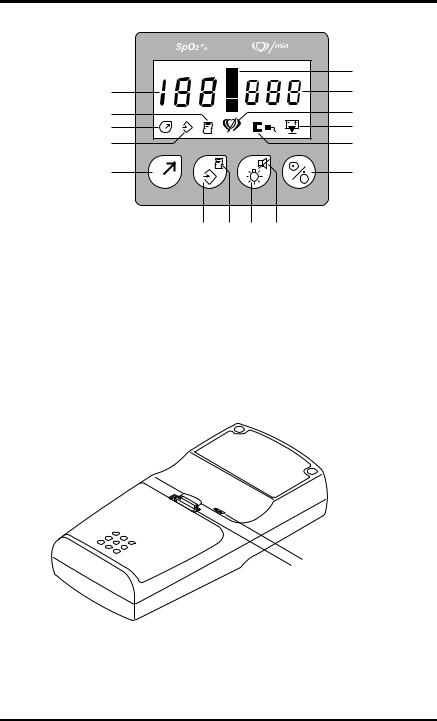
Controls, Indicators, and Symbols
|
1 |
15 |
2 |
14 |
3 |
13 |
4 |
12 |
5 |
11 |
6 |
|
10 |
9 |
8 |
7 |
|
1. |
Pulse Amplitude indicator |
|
|
9. |
(Shift+) Print key |
2. |
Pulse Rate display |
|
|
10. |
Store Data key |
3. |
Pulse Search indicator |
|
|
11. |
Shift Key |
4. |
Low Battery indicator |
|
|
12. |
Store Data icon |
5. |
Sensor Disconnect indicator |
|
13. |
Shift Key icon |
|
6. |
Power On/Off key |
|
|
14. |
Print icon |
7. |
(Shift+) Beep On/Off key |
|
|
15. |
SpO2% display |
8. |
Display Light key |
|
|
|
|
Figure 2: NPB-40 Front Panel Display
 2 1 3
2 1 3
1. Sound ports
2. Battery compartment latch
3. Battery compartment door
Figure 3: NPB-40 Rear View
6
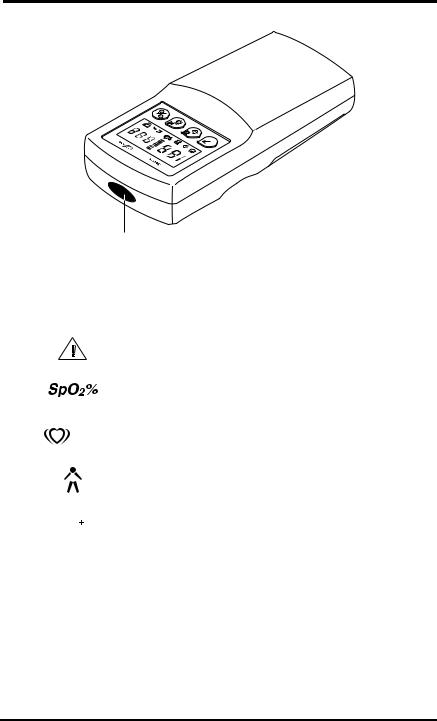
Controls, Indicators, and Symbols
1. Printer infrared window
1
Figure 4: NPB-40 Top View
OTHER NPB-40 SYMBOLS
|
|
|
|
|
|
|
|
Attention: See Instructions for Use |
|
|
|
|
|
|
|
|
Percent oxygen saturation |
|
|
|
/min |
Pulse rate, measured in beats per minute (bpm) |
||||
|
|
|
|
|
|
|
|
Type BF equipment |
|
|
|
|
|
|
|
|
|
|
|
|
|
|
|
|
|
|
|
|
|
|
|
|
|
|
|
|
|
|
|
|
|
|
|
Alkaline “AA” size, 1.5 V batteries |
|
|
|
|
|
|
|
|
|
|
|
|
|
|
|
|
|
|
|
|
|
|
|
|
|
|
|
7

Controls, Indicators, and Symbols
DESCRIPTION OF CONTROLS
Function Keys
Power On/Off key. This key is used to turn the
NPB-40 monitor on or off.
Shift key. When pressed in conjunction with another Function key, the Shift key changes the function of the other key to that designated by its upper icon.
Combo 1 key. When pressed by itself, this key functions as the Store Data key (lower icon). It stores the currently displayed patient data for printing at a later time.
Pressing the Shift key before pressing the Combo1 key, changes the function to that of a Print key (upper icon). This action sends patient data to an active, properly aligned, HewlettPackard printer, to generate a printed report.
Combo 2 key. When pressed by itself, this key functions as the Display Light key (lower icon). It turns the display backlight on or off.
Pressing the Shift key before pressing the Combo 2 key, changes the function that of a Beep On/Off key (upper icon). This action silences or adjusts the pulse beep volume (see “Silencing or Adjusting Beep Volume” in the Start-Up and Use section of this manual).
Status Icons
Shift icon lights when the Shift key function is in use.
Store Data icon lights when the Store Data function is in use. While the icon is lit, either during data storage or printing, the event number is shown on the display.
8

Controls, Indicators, and Symbols
Print icon lights when the Print function is in use. Note: while printing, the monitor does not measure SpO2 .
The Pulse Search icon lights prior to initial acquisition of a pulse signal, and during Pulse Search mode.
The Low Battery icon flashes when 45 minutes or less battery capacity remains (with disposable batteries). The icon flashes at least once per second. Refer to “Battery Operation” in the StartUp and Use section for a discussion regarding use of disposable and rechargeable batteries.
The Sensor Disconnect icon lights when the
NPB-40 does not detect the connection of an
SpO2 sensor to the monitor.
DESCRIPTION OF VISUAL INDICATORS AND DISPLAYS
The SpO2% display show hemoglobin oxygen saturation level. It is updated with each pulse. Synchronous with each pulse, the monitor beeps. If the SpO2 level drops by more than 2%, the monitor will emit a double-beep tone.
The Pulse Amplitude indicator is a 10-segment display that shows the relative pulse amplitude. As the detected pulse becomes stronger, more contiguous segments light with each pulse.
The digital Pulse Rate display shows the pulse rate in beats per minute. It is updated with each pulse.
9

Controls, Indicators, and Symbols
DESCRIPTION OF AUDIBLE INDICATORS
Following are audible indicators for which there are no accompanying symbols, keys, or visual indicators.
WARNING: The NPB-40 is not equipped with alarms. The monitor is for attended monitoring only, and must be used under the direct observation of a qualified health care provider.
Power-Up Self-Test pass |
One 2-second tone |
No sensor connected at start- |
Error tone (dual-pitch tone) |
up (or sensor disconnected) |
for 3 seconds |
SpO2 drop of more than 2% |
1 double-beep tone |
No Pulse detected for |
2 triple-beeps, then NPB-40 |
30 seconds after power-up |
turns itself off |
Pulse acquired, then lost. No |
2 triple-beeps, then NPB-40 |
pulse detected for 15 minutes, |
turns itself off |
and event memory is empty. |
|
Pulse acquired, then lost. No |
1 triple-beep every |
pulse detected for 60 minutes, |
10 seconds |
and event memory is not |
|
empty. |
|
Low Battery |
1 triple-beep tone at |
|
3-minute intervals |
Impending Dead Battery |
2 triple-beep tones, then |
|
NPB-40 turns itself off |
10

SETUP
Unpacking and Inspection
Testing
List of Components
Monitor Setup
UNPACKING AND INSPECTION
Notify the carrier if the shipping carton is damaged. Unpack the NPB-40 and components. If anything is missing or damaged, contact Mallinckrodt Technical Services Department or your local Mallinckrodt representative.
TESTING
Before using the NPB-40 in a clinical setting, verify that the monitor functions properly by following the instructions in the Start-Up and Use section of this manual.
LIST OF COMPONENTS
1 Nellcor NPB-40 handheld pulse oximeter
4 Alkaline “AA” size, 1.5 V batteries
1 Durasensor® oxygen transducer, model DS-100A
1 Operator’s manual
1 Quick Guide adhesive label
Optional Accessories
The following items are available from Mallinckrodt for use with this monitor:
•Protective “Boot”
•Rain Jacket
•Carrying Case
•Hewlett-Packard printer, model HP82240B
•Hewlett-Packard printer paper
11
